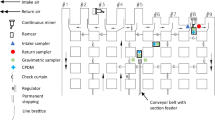Abstract
Due to the successful application of roof bolter canopy air curtains (CACs) to protect roof bolter operators from high levels of coal mine respirable dust, a shuttle car CAC is currently being developed. Since a shuttle car consistently trams from the continuous miner to the feeder and back at a speed up to 9.66 kph (6 mph) or 2.68 m/s (528 fpm), it is thought that the shuttle car may encounter very high air velocities (mine ventilation air velocity + max shuttle speed (2.68 m/s (528 fpm)). Past research and preliminary lab testing showed that CAC protection in high interference air velocities is difficult to achieve. Therefore, testing was conducted at a Midwestern US coal mine to determine the air velocities their shuttle car actually encounters. This mine used ram dump cars as their shuttle cars. Results showed that coal mine dust exposure is generally very low at the feeder and when tramming. Elevated concentrations are encountered at the ram dump car operator position when the car is being loaded by the continuous miner. Recorded air velocities while tramming did not reach the max air velocity of mine ventilation air velocity + 2.68 m/s (528 fpm) calculated as 3.32 m/s (653 fpm). High velocities, while encountered, were of low frequency and associated with low respirable coal mine dust concentrations. Therefore, using this new information, designing the shuttle car CAC for maximum interference air velocity may not be as important as previously thought.







Similar content being viewed by others
References
Engel, M., Johnson, D., & Raether, T. (1987). Improved canopy air curtain systems. In USBM OFR 25-88, Contract #J0318014. Washington, DC: US Bureau of Mines.
Goodman, J. V. R., & Organiscak, J. A. (2002). Evaluation of methods for controlling silica dust exposures of roof bolters. Transactions of the Society of Mining, Metallurgy, and Exploration 2003, 312, 133–137.
Joy Global. (2016). Haulage Systems Product Overview. Rolling Meadows: Komatsu America Corp https://mining.komatsu/docs/default-source/product-documents/underground/room-and-pillar-entry-development/haulage-systems-brochure.pdf?sfvrsn=77790a6b_38. Accessed 20 June 2019.
Listak, J. M., & Beck, T. W. (2012). Development of a canopy air curtain to reduce roof bolters’ dust exposure. Mining Engineering., 64(7), 72–79.
NIOSH. (2011). In J. D. Potts, W. R. Reed, & J. F. Colinet (Eds.), Evaluation of Face Dust Concentrations at Mines Using Deep-Cutting Practices. Pittsburgh: U.S. Dept. of Health and Human Services, Centers for Disease Control and Prevention, National Institute for Occupational Safety and Health, DHHS (NIOSH) Publication 2011-131, RI 9680.
NIOSH. (2013). In J. F. Colinet, W. R. Reed, & J. D. Potts (Eds.), Impact on Respirable Dust Levels when Operating a Flooded-Bed Scrubber in 20-foot Cuts. Pittsburgh: U.S. Department of Health and Human Services, Centers for Disease Control and Prevention, National Institute for Occupational Safety and Health, DHHS (NIOSH) Publication 2014-105, RI 9693.
Reed, W. R., Zheng, Y., Ross, G., Salem, A., & Yekich, M. (2018). Laboratory testing of a shuttle car canopy air curtain for respirable coal mine dust control. Int J Coal Sci Technol, 5(3), 305–314.
Reed, W. R., Klima, S., Shahan, M., Ross, G., Bailey, A., Cross, R., Grounds, T., & Singh, K. (2019). A field study of a re-designed roof bolter canopy air curtain (2nd generation) for respirable coal mine dust control. International Journal of Mining Science and Technology. https://doi.org/10.1016/j.ijmst.2019.02.005.
Stefanko, R. (1983). Coal Mining Technology, Theory and Practice. In Society of Mining Engineers. New York: American Institute of Mining, Metallurgical, and Petroleum Engineers, Inc.
Williams, K. L., & Timko, R. J. (1984). Performance evaluation of a real-time aerosol monitor, Information Circular 8968. Pittsburgh: U.S. Department of the Interior, U.S. Bureau of Mines.
Author information
Authors and Affiliations
Corresponding author
Ethics declarations
Disclaimer
The findings and conclusions in this report are those of the author(s) and do not necessarily represent of the official position of the National Institute for Occupational Safety and Health. Mention of any company name, product, or software does not constitute endorsement by NIOSH.
Additional information
Publisher’s note
Springer Nature remains neutral with regard to jurisdictional claims in published maps and institutional affiliations.
Appendix
Appendix
Ram dump car traverses showing dust concentration and air velocity encountered during cycle. Blue-shaded areas = time behind CM, green-shaded areas = time at feeder.
Rights and permissions
About this article
Cite this article
Reed, W.R., Shahan, M., Ross, G. et al. Field investigation to measure airflow velocities of a ram dump car using circular routing at a Midwestern underground coal mine: a case study. Environ Monit Assess 191, 515 (2019). https://doi.org/10.1007/s10661-019-7624-8
Received:
Accepted:
Published:
DOI: https://doi.org/10.1007/s10661-019-7624-8














